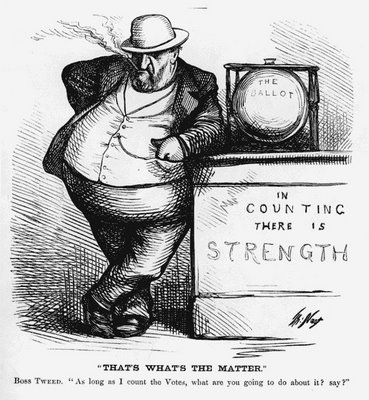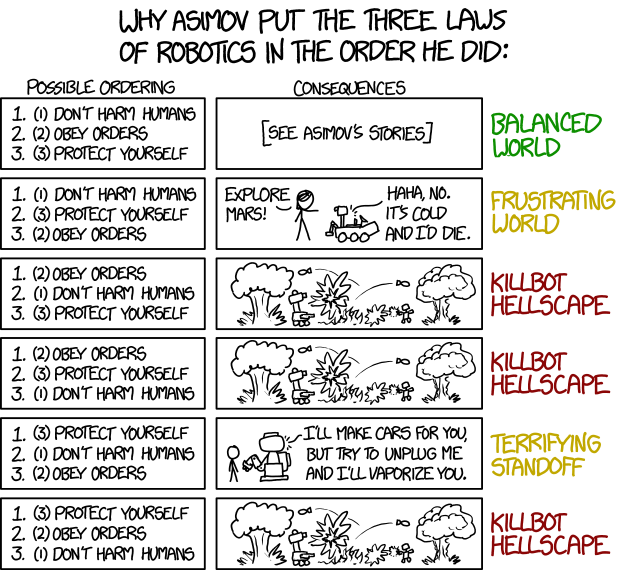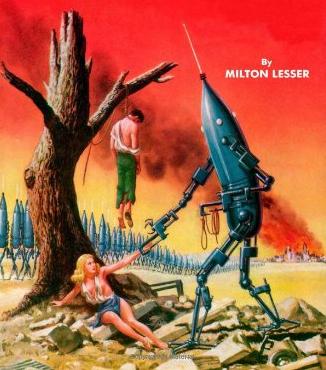
A few days ago there was some back-and-forth over at Ken MacLeod’s blog, and then also at Roderick’s blog, over the the relationship between large, centralized states and peace. MacLeod originally argued:
The panel convened by Farah Mendlesohn on Pacifism and Non-Violence in SF
benefited from being on a subject on which there is a manageably small amount of source material. The discussion led me to make one of my very few comments from the floor. A more articulate and argued version of that comment would be this:
We already know how to have peace over large areas of the Earth, and that is by having large states covering those areas. (The combat death rate for men of military age in typical stateless societies far exceeds that in inter-state wars, including world wars.) SF has in its default assumptions a way to get to peace without pacifism, and that is the World State. Even Starship Troopers gives this answer, just as much as Star Trek or anything by H. G. Wells, Isaac Asimov or Arthur C. Clarke. Heinlein’s Federation is a World State, and (consequently) there is peace within the human species. It just has wars with aliens.
But there are no aliens. So we could have peace.
—Ken MacLeod, The Early Days of a Better Nation (2009-04-17):
Existence Proof of Von Neumann Machine, Placing Imaginary Bets, and other Cultural Learnings
There are several problems with this line of argument. There’s a lot of good back-and-forth at MacLeod’s about the empirical basis of MacLeod’s factoid about combat death rates, and about the underlying sources (it mainly comes from Lawrence Keeley’s War Before Civilization). Roderick has a very interesting response, from another angle, in the comments there that he repeats in his own post, in which he argues that if there is a general correlation between peace and state coverage, it’s because states (as parasites on social production) can only function in societies where there is an certain underlying level of peaceful cooperation; there is a level of widespread ultraviolence at which at a state can no longer steal the material resources it needs to cover the costs of full-time cops, soldiers, and the rest of its repressive apparatus. Hence the correlation between production and the State is like the correlation between human civilization and cockroaches; cockroaches thrive in civilized societies much more than they do in the wilderness, but not because cockroaches somehow produce civilization.
All of which is good, and important, and well-worth reading. What I’d like to add to the discussion is a good, hard look at the notion that what a strong state produces within its own territory can even realistically be called peace.
Let’s grant, for the sake of argument, that Keeley (thus MacLeod) is right about combat deaths for military-age males — that the rates are much, much higher in primitive stateless societies than they are in modern state societies. As Roderick points out, part of the problem here is that that data set, by itself, tells us little or nothing about whether it’s the primitiveness or the statelessness that’s doing the damage. There are other problems, too — for example, comparing percentages is a tricky game when you compare populations of radically different sizes; if a band of 50 !Kung San gets in a fight, and one whole member of their band is killed, then just running the percentages would have us believe that this is like 6,000,000 out of 300,000,00 Americans getting murdered — life for the !Kung San is apparently so savage that every single murder is another Holocaust. Or maybe there is a problem with a standard of comparison which would require 0.000000167 of a !Kung San man or woman to be killed in order to find an equivalent to a single murder in America.
But the problem that I want to focus on is that it looks to me like we are doing some very selective counting here. The selective counting consists in what is counted as violence,
and as breaches of peace,
and what is not. We are informed that having large states covering
a part of the world’s landed surface is a good way to bring about peace. The evidence for this is the drop-off in combat deaths. But combat deaths are not the only sort of violence that people can suffer, and especially not combat-deaths-among-military-aged-males. Keeping that in mind, let us recall some facts about the most powerful, and one of the largest states in the world today — the United States of America — and what goes on in the territory that its government claims to rule.
Under the United States of America, over 2,000,000 people are currently forced into jails and prisons by state, local, and federal governments. Over 7,000,000 people are facing some form of ongoing constraint from the government’s corrections
system — either through imprisonment, or through supervised parole, or through probation.
Under the United States of America, the government maintains a force of over 1,100,000 police officers — armed professionals whose job it is to use force against the 7,000,000, so as to get them under the control of the government prison system and its annexes. The government also maintains a force of about 765,000 corrections officers,
who are armed and trained to use force against the 2,000,000 while they are confined within the walls of the government’s prisons.
The government’s internal armed forces of over 1,865,000 are currently engaged in a number of large-scale projects to use intense force in the prosecution of campaigns that they describe as wars.
There is, for example, the War on Drugs; the War on Terrorism; inner-city surges
against gangs, and so on. For the prosecution of these wars, the 1,865,000 put on constant street patrols; they arm themselves with semiautomatic and fully-automatic rifles; they kick in doors and storm houses and businesses; in some neighborhoods they engage in saturation patrols,
the explicit purpose of which is to instill a sense of fear and thus make their designated enemies (gangs,
mostly) afraid to use public spaces. In some cities they have adopted tactics explicitly modeled on the government military’s surge
counter-insurgency tactics in Iraq. In other cities they have established checkpoints on the roads and cordoned off entire neighborhoods. They have recently taken to investing heavily in training and equipping paramilitary defensive lines (riot cops) and paramilitary assault squads (SWAT), and have stocked up on armored vehicles for mechanized warfare and even military helicopters.
When the government’s 1,865,000 go out into the streets or into the jails and prisons, they use force to confront and control the 7,000,000, and also to confront and control uncounted millions more, who are confronted by law enforcement and corrections officers without ending up in jail, in prison, on parole, or on probation. These confrontations produce conflicts, and the conflicts often escalate into violence; under the United States of America, those fights result in cops killing somewhere above 500 people each year[] and about 50 cops getting killed each year along the way. Upwards of 550 deaths a year, out of 300,000,000 people, may not seem like all that much; but it’s worth remembering that there is a body count here, and, what’s more important, that the body count is not the only form of violence that there is to talk about. Besides the people who end up dead, there is a far greater level of non-lethal but nevertheless violent force, which hasn’t got much of a counterpart in the kind of kill-or-be-killed struggles that the body-counters count as breaches of peace:
there is the heavy and repeated use of physical coercion, assaults, beatings, restraints, chemical and electrical torture (pain compliance
), that the cops and their antagonists each employ (mostly, it’s the cops who use it) to try to get their way. This violence is constant, pervasive, and intense, and all of these especially in those neighborhoods that are singled out, for demographic reasons, as deserving the special attention of police street patrols and police crackdowns. In neighborhoods like that, the cumulative result is often experienced as being far more like a military occupation than like life in a peaceful
society. And this kind of constant, pervasive, intense violence is completely unknown in even the most primitive or ultraviolent stateless societies.
This constant government-declared domestic warfare — most of which is directed against people for offenses
that violate nobody’s person or property, such as the use of drugs or the crossing of borders without government permission slips — is dignified as peace
by those who claim that covering a territory with a single state eliminates war within that territory. In fact it is nothing of the sort, if peace
has any meaning for people’s real lives and not merely for the purposes of politico-legal accounting. It is a form of violence which affects military age males
but also a lot of other people besides, and which often has far more profound effects on daily life than the bloody but infrequent violence of communal blood feuds or open war between political entities. And in many cases outside of the United States, it is a form of violence which has proved far more intense and far more lethal than it happens to be here — because, as R.J. Rummel never tires of pointing out, over the past couple centuries, governments have been far more lethal in democidal attacks on their own populations — through the use of government executions, government policing (especially government policing of the use of food stocks), government prison camps, and so on — than they were in inter-governmental warfare. The greatest war of the modern era has never been the kind of warfare that governments wage one against the other — as terrible as those wars have been. It is the war that each and every government is constantly waging within its own territory, against its own subjects — the kind of war that is passed off as peace,
and which is more or less never counted in attempts to tally up the balance of peace over violence in modern state-occupied societies.
See also:




